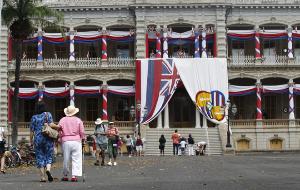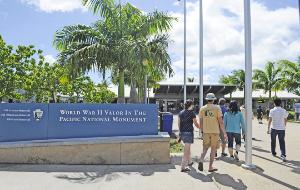PRESERVATION IN THE NEWS: The inaugural Hawaii Heritage & Hospitality Forum on October 31 brought together a diverse group of Hawaii professionals and cultural stewards to share ideas on how to thoughtfully expand heritage tourism in the islands. Allison Schaefers of the Star Advertiser shares some insights gleaned from members of the forum’s planning committee on the eve of the event.
Tourists will be encouraged to look beyond the beach
What will bring visitors back to Hawaii once they’ve experienced its famous sun, sand and surf? And, how can the state get first-timers to visit if they aren’t beachgoers?
The Historic Hawai’i Foundation and the Hawaii Tourism Authority aim to answer those questions and more during a one-day inaugural forum on heritage tourism scheduled Friday at the Hawai’i Convention Center. There some 150 travel industry professionals, cultural stewards, nonprofit organizations, ecotourism groups and other community stakeholders will explore ways to preserve Hawaii’s unique sense of place while providing a high-quality visitor experience that goes beyond Hawaii’s traditional leisure branding.

he Historic Hawai‘i Foundation and the Hawaii Tourism Authority will hold an inaugural forum Friday on heritage tourism. Promoting the islands’ history and culture is a way of getting travelers to return to Hawaii. Visitors arrive at Iolani Palace during the commemoration of King Kalakaua’s birthday. (Photo credit: Krystle Marcellus / 2013)
“We are proud to facilitate this discussion dedicated to preserving Hawaii’s diverse and unique history,” said Kiersten Faulkner, executive director of the Historic Hawai’i Foundation. “This is the first time that the visitor and heritage industries will come together. While Hawaii has done an outstanding job in explaining the aloha, culture, nature and beauty that makes it different than other places, we really have room to grow in explaining the history of this place.”
The forum includes plenary presentations, concurrent educational sessions and a luncheon with keynote speaker Andrew Te Whaiti, managing director of The Department of Discovery, a New Zealand-based brand tourism company. Andrew Witt, executive director of the St. Johns Cultural Council in Florida, will deliver the plenary talk. In addition, an exhibition will be held for participating heritage sites and travel industry operators to showcase their services.
While some of Hawaii’s cultural and heritage charms like those pertaining to Pearl Harbor are widely known, others like Iolani Palace don’t come readily to mind, said Witt, who draws parallels between the opportunities and challenges shared by Hawaii and his home of St. Augustine, Fla., the oldest city in the U.S.
“I’ve never been to Hawaii, and I didn’t know much about it (except for)what I’ve seen on television such as Waikiki Beach, the golf courses, the agriculture,” Witt said. “So I did a Google search, and I discovered that one of the facts about Hawaii is that it has the only royal palace in the U.S. That’s the equivalent of the White House. … I think that’s a wonderful story. It’s probably not marketed as a significant heritage site.”
Faulkner agrees, adding that there are potentially thousands of cultural and heritage sites throughout Hawaii that have stories that should be shared, but in a context that isn’t overwhelming.

The USS Arizona and Pearl Harbor are some of the biggest draws for visitors seeking out cultural and heritage sites in Hawaii. Visitors make their way to the Pearl Harbor Visitor Center, entrance to the World War II Valor in the Pacific National Monument. (Photo credit: Bruce Asato / basato@staradvertiser.com)
“Many are well known such as the USS Arizona, the USS Bowfin, Punchbowl and the Pacific Aviation Museum. Others are not as appropriate for people to visit in large scale, and then we have everything in between,” she said. “We’ll talk about carrying capacity, discussing what places could accommodate more visitors and which sites really shouldn’t be open to the public. It’s not a one-size-fits-all model; we have to find the right balance.”
There’s more money to be made if Hawaii’s visitor industry works with the state’s heritage industry to better develop its cultural and heritage brands, said Frank Haas, principal of Marketing Management Inc.
“Product news is the lifeblood of marketing. We can’t build new hotels as often as Las Vegas, so we need to reinvent the destination in other ways,” Haas said. “One of the biggest advantages of cultural and heritage tourism is that the people who participate tend to spend more money and stay longer than a typical visitor.”
Promoting heritage tourism also creates opportunities to more effectively market Hawaii to repeat travelers, who comprise about 70 percent of the state’s total visitors annually, and first-time visitors from emerging markets.
“Chinese are not beach people. They want to see sites and understand the place,” he said. “It might surprise you to know that visiting Chinatown is one of their favorite things to do. In the case of the Chinese, we have a very specific thing to talk about in our relationship with Sun Yat-sen, who is known as the father of modern China.”
In addition to growing tourism, Witt said heritage tourism builds community.
“These assets are a hallmark of pride in communities. If we can monetize them by appealing to heritage travelers who will pay to visit the sites, we are addressing the preservation side by creating a revenue stream for that effort,” he said.
For more information on heritage tourism initiatives, visit www.hhh.historichawaii.org. Attendance at the forum is closed; however, it will be rebroadcast Nov. 27-30 on Olelo Community Media.
HERITAGE TOURISM BY THE NUMBERS
Seventy-eight percent of all U.S. leisure travelers, or 118.3 million adults, participated in cultural and/or heritage activities while traveling.
Cultural and heritage travelers from the U.S. spent an average of $994 per trip, contributing more than $192 billion annually to the U.S. economy. In comparison, the average leisure traveler spent $611 per trip.
Forty percent of all leisure travelers in the U.S. alone can be classified as those who actively engage in cultural and heritage travel. They contributed nearly $124 billion to the U.S. economy.
Twenty-four percent of U.S. leisure travelers, or 36 million adults, were planning on taking a cultural/heritage trip within 12 months.
U.S. cultural/heritage travelers took an average of five trips in a year compared with slightly less than four trips for noncultural/heritage travelers.
Source: Mandala Research, 2010

